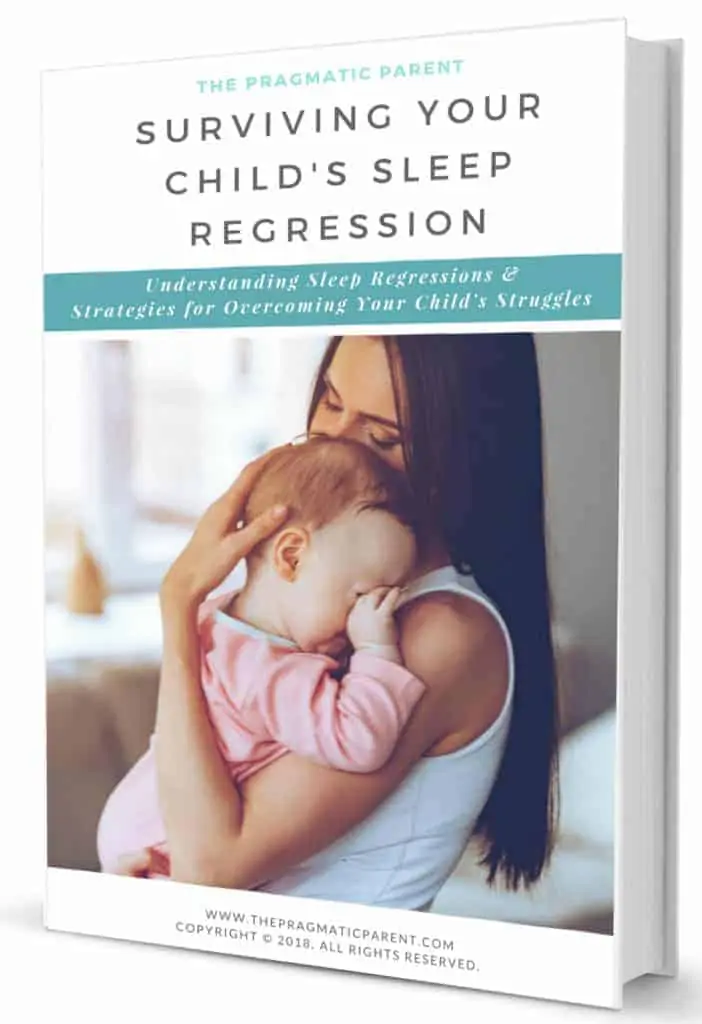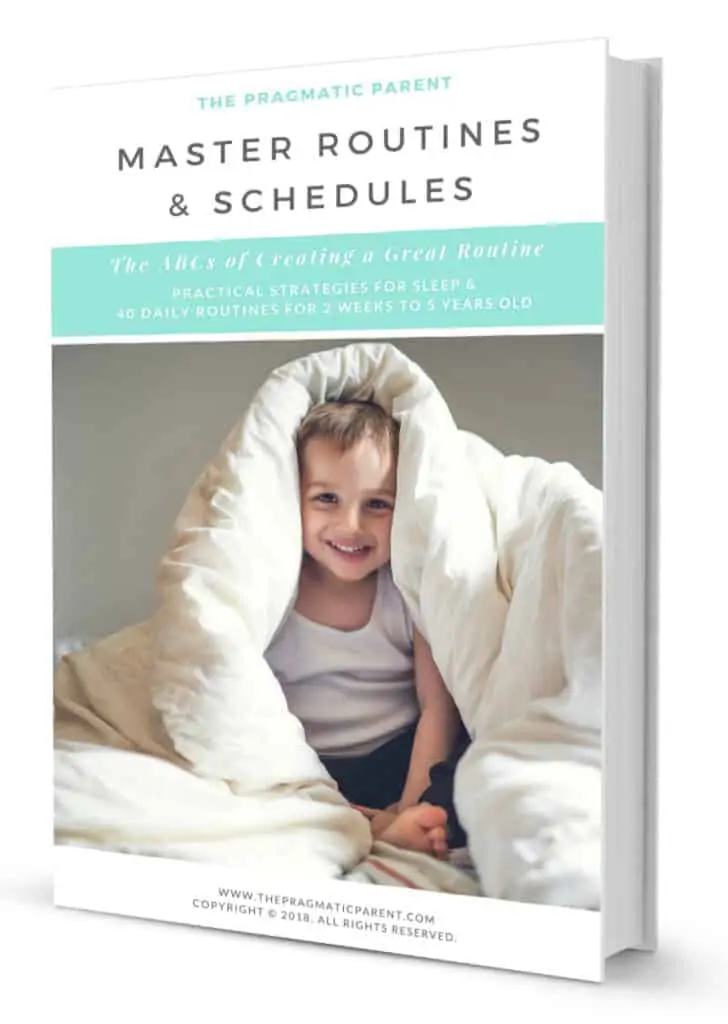If your child is having trouble falling asleep on their own, fighting bedtime and wide awake instead of sleepy, it might be time to try these 10 tips to help the child who doesn’t want to go to bed. There are many reasons why your child may be fighting bedtime including major sleep regression phases (particularly the 18 month sleep regression and 20 month sleep regression which wreck havoc on toddlers at sleep times,) but you’ll find a ton of resources that have helped my own three children get back on track when sleeplessness, anxiety, worries, nighttime fears, potty training and other factors got int he way of a good night’s sleep.
Children love to throw parents for a loop with their sleep habits. One minute your child is sound asleep in the snap of the fingers and sleeping through the night like a champ, but then suddenly they’re in and out of their bed after you’ve already tucked them in three times and waking up much too often during the night.
If your child is going through a Sleep regressions (the 18 month sleep regression or 20 month sleep regression) which are all developmental sleep phases you’ll see several times from 6 weeks to two years old, don’t lose hope yet Mama.
If your child is waking up four times a night, there is a solution to this! If your child has stared having nighttime fears and worries about going to sleep, this will help him learn to overcome these fears.
There are ways you can help soothe your child during these rough sleep patches, and help them to fall asleep peacefully on their own. Check out these 10 helpful ways you can calm the kid who fights bedtime and return your house to a nighttime state of zen once again.
Stick to a Consistent Bedtime Routine
Maintaining a consistent bedtime routine where your children walk through the same steps to preparing for bed each night, and go to bed at the same time, makes all the difference in children who fall asleep on their own and those who are in and out of their bed.
Download Your Routine Tracker – The Starting Place for Creating a Better Routine and Great Sleep Habits
Children bodies who follow a consistent routine begin to wind down faster and the wordless cues that it’s time for bed help them to peacefully fall asleep on their own.
Reinforce your child’s appropriate bedtime by using a consistent bedtime routine. Don’t hold her, rock her, or let her rely on a pacifier or bottle to get to sleep. … Stick to a regular pattern of daytime and nighttime sleep; don’t let your toddler set her own sleep schedules.
Routine charts & cards help children learn the steps to their bedtime routine without nagging or reminding, and also help them to be independent. You can check out the boy and girl routine cards here.
Additional Resources for Creating a Consistent Bedtime Routine:
- How to Establish a Peaceful Bedtime Routine for Your Baby
- Create an Awesome Routine for Better Sleep Habits
- How to Survive the 18 Month Sleep Regression & 2 Year Sleep Regressions Without Going Crazy
- The Benefits of Having a Daily Routine
Squash Nighttime Fears
Around 24 months, and sometimes all the way up until 6 and 7 years old, children begin to have night fears. They may think there is something under the bed, hiding in the closet or a dark room scares them. As an adult, it’s easy to see through these fears, but telling a scared child that there is nothing to worry about, won’t stop them from being afraid.
Dismissing nighttime fears doesn’t make them go away, but you can help your child talk through why they have this fear and recognize where it came from. Maybe it was a book, or movie they saw, or a scary story someone from school told. When a child is able to walk through and then understand where the fear originates from on their own, them they can move forward and see the fear is not real.
Comforting solutions also make kids feel safe and reassured as they work through night fears.
- Nightlight
- Bedside Glow Lamp
- Bedroom Star Projector
- Make Your Own Monster Spray
- Worry Eater Stuffed Animal
Comfort Items Have a Calming Effect
A stuffed animal, favorite blanket or item of comfort can help a child settle into a peaceful state of sleep and again, offer comfort during the night if they wake up.
Is there an item your child always reaches or asks for when they’re upset, napping or carrying around the house? If not, let them chose something – you may already have it around your house or could take them shopping for a new stuffed animal or item – they want to cuddle with during the night.
Cut Screentime One Hour Before Bed
Adults know how bad looking at screens can be for sleep, but the same rings true for kids. Shut off all devices – TV, phones, tablets and other digital devices – at least one hour before bedtime. The blue light that’s emitted by devices can prevent the body’s natural release of melatonin.
Here are 10 screen-free alternatives before bedtime your entire family will love.
Sound Machines Aren’t Just for Babies
Babies aren’t the only benefactors of a sound machine. A sound machine set on white noise or ocean waves can settle a child into a dreamy sleep versus if there is no noise at all.
Think about this. When a room is completely silent, children will hear things going on outside their room. It may be outside of the house such as passing cars, horns honking, a car alarm, firetrucks and other noise that can startle and wake them up or keep them from falling to asleep.
Another reason a sound machine helps is because around the age of 18-24 months, children go through a period of separation anxiety. This is not only separation anxiety from being away from their favorite person which may be Mom or Dad, but also they don’t want to miss out on the fun. A sound machine mutes the rest of the noise from the house so your children can’t hear you watching Netflix or listening to music and try to stay up and join you.
A soothing sound machine set on a low decibel level, will soothe tired kids to sleep at the start and middle of the night if they wake up.
Eliminate Stimulants
Children who have some anxiety and sleeplessness before bedtime can be super sensitive (or it can be caused by) stimulants found in drinks and food. Caffeine, energy drinks, sugary juices and even chocolate (sorry, Rocky Road) all have stimulants which counter the body’s natural inclination to wind down and fall asleep.
Cut caffeine after 3pm in the day to help wind down when it’s time to hit the sack.
Try a Special Clock With Visual Cues
Having a kid-friendly clock in your child’s room can help them to see when it’s sleep time and when it’s awake time. Kids are very visually oriented and a kid-friendly alarm clock built with visuals that explain nighttime and daytime can be a lifesaver.
This Kid’sleep Globetrotter Clock has two functions – sleep time and awake time. This is good for toddlers who need a no-fuss simple clock with visual cues to tell them that it’s still bedtime if they wake up too early or in the middle of night. Plus, it’s ultra lightweight and easy to pack if you head out of town and need to take with you.
The Stoplight Alarm Clock tells kids via stoplight when it’s time to sleep (red light), and when it’s time to wake up (green light.) You can set the times for nap and bedtime and it has can optional beeping alarm function. This was the clock we used to help teach our kids when it was time to wake up after a few weeks of waking up too early.
Use a Reward Chart for Positive Bedtime Behavior
If bedtime is a challenge for your children, but they respond well to incentives for making positive choices and having good behavior, a reward chart could be the motivation they need.
Reward charts incentivize positive choices like staying in bed after you’ve tucked them in or not coming out of their room until the sun has come up. Children who can visually see the progress they’re making towards earning a reward, will be encouraged by this strategy.
Rewards don’t have to be big or expensive, they can be simple such as:
- Coupons for a night out with Mom or Dad
- Pizza & Movie Night
- Sucker or Piece of Candy
- New Hairbands or a Headband
- $1 Toys from Target or another Store
- Matchbox Cars
Calming Essential Oils
There are proven scents that help the body calm down, and slip into a peaceful state which helps the body more easily fall asleep. Lavender, peace and calming, vetiver and orange and Roman Chamomile are great natural scents you can find in sprays, essential oils and even essential oil rolls.
We used to roll Lavender on the bottom of our toddler’s feet to help her settle for the night or sometimes a small spray or two on the pillow of Lavender helped, and smells wonderful!
- Lavender Roller
- Pure Lavender Spray
- Lavender Essential Oil
- Vetiver Essential Oil
- Peace & Calming Essential Oil
- Roman Chamomile Essential Oil
- Diffuser Humidifier
Limit Before Bedtime Fluids
Be careful to regulate the amount of fluids your child is taking in before bedtime. The time around potty training can increase the number of times they’ll be up at night, but for older kids, the more fluids they drink, the more they’ll be up at night. These sleep disturbances can cause bedwetting and waking up in the middle of important sleep cycles.
Limit drinking water after dinnertime and only drink water when brushing teeth. Be sure to use the bathroom before climbing into bed too!
Slow Down & Connect Before Bedtime
Right before bed is the most important time to squeeze in time for connecting with your kids, so don’t skip the pillow talk. Snuggle with them in bed, read a book, talk about the day, share your thoughts, listen and use the time to settle down together and sweetly connect with one another.
This does’t mean you don’t set limits so you aren’t in the room all night or creating a bad habit of letting them stay up past their bedtime. Set a limit of 5 or 10 minutes of one-on-one time to connect with each of your kids and then let them know it’s time to go to bed afterwards.
Some nights sleep may feel like a hard fought battle when you have kids but the most important thing you can do to keep good sleep habits is to be consistent, offer comfort and give them the tools to want to be successful. In the meantime, try all these tips that have worked in our home and hopefully give you a little relief in yours
Download Your Routine Tracker – The Starting Place for Creating a Better Routine and Great Sleep Habits
Helpful Resources for Handling Sleep Problems, Sleep Regression & Mastering Your Routine
Surviving Your Child’s Sleep Regressions Ebook

You Might Like…
- How to Establish a Peaceful Bedtime Routine for Your Baby
- Create an Awesome Routine for Better Sleep Habits
- How to Survive the 18 Month Sleep Regression & 2 Year Sleep Regressions Without Going Crazy
- The Benefits of Having a Daily Routine
Want even more?
Shop All Parenting Resources
Shop all of our parenting resources from self-regulation tools and managing big emotions to building self esteem and confidence. There are resources for all seasons of life!








I cant control, my babes, sleeping routine and I am so worried about it. I can feed him when he is asleep. If you have any better solution then place help me.